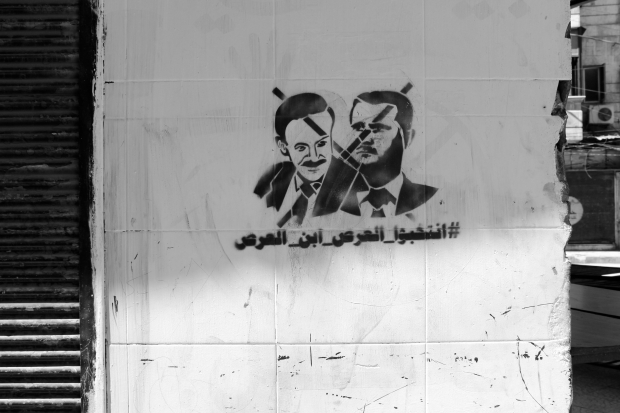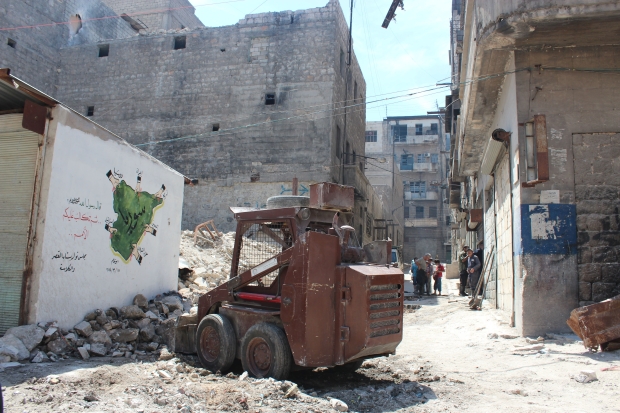Picture imperfect: Artists help Aleppo to heal amidst the ruins

Aleppo, SYRIA – A father and son stand next to each other in a small, cobblestone courtyard. The 10-year-old boy looks up to his father dotingly, watching his every move.
His father asks him to imagine a banana. “Imagine it’s just ripe to eat. And then imagine peeling it,” the father says, as he gestures with his hands, and pretends to take a bite.
Now, he says to his son, “Imagine that you are free. But don’t say that word out loud. If the police hear, you will go to prison.”
The father then opens a birdcage hanging behind him and lets a bird go free. Just as the bird begins to fly away, a government sniper shoots it down. “This is what freedom looks like in Syria,” the father says.
All the men crowded next to the computer screen displaying the film chuckle, as they sip their Turkish coffee in a neighbourhood in an opposition-held area of Aleppo.
They had just watched a four-minute video, one episode of a new television series activists in Aleppo are producing.
“Maybe you can kill me, but you can’t kill my soul,” the television show’s director, Abu Mohammed, said after watching the clip.
There are no exact figures on the number of people remaining in Aleppo, but it is estimated 70 percent of the city's residents have fled.
While many can’t leave because it is too expensive or because don’t have a passport, others have decided to stay, believing that art could play an important role in documenting the war.
A channel for tomorrow
Mohammed, who is also known in this part of the city as “the face of the revolution”, was working in advertising before the war began.
He decided to put together a TV series, together with two dozen others, to provide some comedic relief for the citizens left in Aleppo.
The group of men, including his young son, make regular appearances on the show.
Others film, do prop design, script-writing and edit the footage.
“We’ve been doing this for about four months, when the barrel-bombing campaign began,” Mohammed said. “In another two months’ time, we will have a total of 13 episodes.”
The group named “The channel of tomorrow will be better” have been marketing and advertising the show, hoping it will be picked up by a television station.
“The message of the show is to provide some humour in the suffering of Syrian people,” Mohammed added. “Many people don’t know about Syria or where it is on a map.”
While the sketches garner a lot of laughs from locals here, in no way does it take away from their suffering. Mohammed and the rest of the group also spend their time delivering bags of food to families in desperate need.
Art therapy
Michelle Lokot, programme manager at the International Rescue’s Committee’s (IRC) empowerment programme, based in Jordan, said art played an important role in the psychological healing of those living through war.
“Art can be a helpful means for people to express and release difficult feelings and emotions,” she said. “Humour can be used in diffusing topics or situations that carry tension.”
According to one IRC psychologist, when incorporated with strategies like role play, humour can be very helpful in helping people to process and cope with difficult issues.
The psychologist added that art was “a type of self-expression that helps people to manage their behaviour, reduce stress and promote self-awareness.”
But producing a television show isn’t the only form of art in Aleppo.
Many of the walls throughout what is left of the city have been painted with various messages about the war.
Painter Abu Nadim, who joined the revolution when it began back in 2011, became famous for working tirelessly, writing slogans on posters for people to take to protests.
In his abandoned old apartment, one room is littered with posters on the floor, a memory, he says, of the initial peaceful protests.
He holds up one that reads: “Claim your Dignity, Claim your Liberty, Claim your Humanity. Join the Syrian Revolution.”
As Nadim drove around the streets of Aleppo, he stopped often to explain the meaning behind his artwork.
“I just want to transfer the right message in the world,” he said, standing next to one of his pictures of a girl and a boy holding hands, with bricks next to them to rebuild the country, regardless of religion.
“Nobody wanted this,” he added, as he pointed to a demolished building.
Another one of his more provocative images is an image of the Syrian nation being torn apart by the hands of different countries, including Iran, Russia, Israel, US, China and Hezbollah, the Lebanese Shiite militia.
Also riddled throughout the streets are images of President Assad and his father, with a cross through it, signalling the widespread view that the election was scheduled on 3 June.
Provocative imagery
“The impact of graffiti depends entirely on the content and message communicated through the graffiti,” an IRC psychologist explained.
“For civilians remaining in Aleppo, the impact may be empowering or disempowering depending on an individual’s personal views or beliefs.”
Back at the warehouse, the camera crew have got their gear ready to shoot another clip for the show. But before they do, they insist on watching part of another episode.
A man sits peacefully as he reads the newspaper on a street in the city. As he flicks through the pages of the government newspaper, he reads that the situation in Syria is very good.
As he continues to read, rockets begin falling down behind him. He continues reading. But before the clip gets to the end, the earth shakes. The sound of a blast reverberates throughout the room. Another barrel bomb dropped on a neighbourhood nearby.
While the sketches may be able to whisk Syrians away from reality for a few minutes, the barrel bomb is a stark reminder that this war is very real.
Stay informed with MEE's newsletters
Sign up to get the latest alerts, insights and analysis, starting with Turkey Unpacked
Middle East Eye delivers independent and unrivalled coverage and analysis of the Middle East, North Africa and beyond. To learn more about republishing this content and the associated fees, please fill out this form. More about MEE can be found here.



